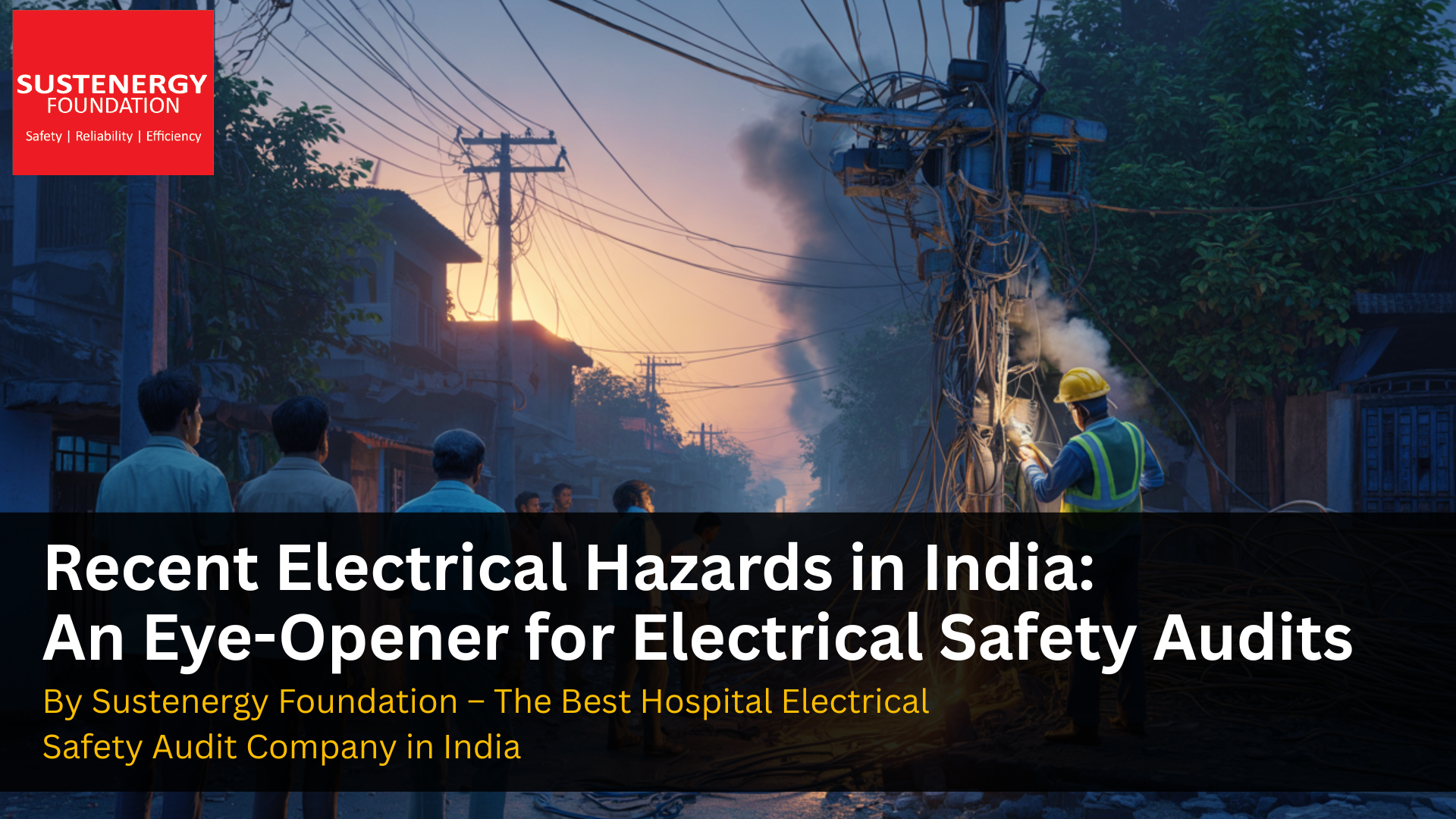
Checklist for Electrical Safety
Why Checklist for Electrical Safety is essential ?
Electricity is essential for the modern world for economical improvements, but it's also a potent force that can cause severe injuries, fatalities, and can create more damages if not handled effectively. A checklist for electrical safety in every organisation must focus on delivering a comprehensive guide to electrical safety, focusing on essential safeguards for human beings to protect their lives, electrical equipment and systems ensuring reliability, commonly used electrical machines in buildings and factories, and operational or maintenance management methods.
1. Electrical Safety for Human Beings
Human safety is of primary importance when it comes to electrical systems and machinery. If anybody comes in contact with electricity, it can lead to serious electrical hazards including minor or major electrical shock which can even lead to fatality. Apart from electrical shock, fire hazards from electrical origins are also a big threat to humanity which includes chalking of lungs due to smoke to burn hazards from fire hazards.
- Training and Awareness: Ensure all employees irrespective of their position receive comprehensive training on electrical safety and regularly participate in refresher courses. Specific training may be provided for engineering team members based on their roles and responsibilities. Electrical safety training and Energy conservation training must be carried out at regular intervals for all operating professionals.
- Personal Protective Equipment (PPE): Mandate the usage of appropriate PPE, such as helmet, insulated gloves, safety shoes, and protective eyewear, arc flash suits based on their nature of work. If working with barefoot , ensure to use Electrical insulating mats especially in hospital critical care units or other sensitive areas where footwear can not be used.
- Safety Signage: Clearly display safety or warning signs and labels on electrical equipment and hazardous areas which includes danger signs, warning signs to specific areas, safety instructions and other customised warnings. Electrical safety posters, Energy conservation posters and other training materials must be effectively used to increase awareness.
- Emergency Procedures: Develop and regularly practice emergency response procedures, including the use of fire extinguishers and first aid measures, electrical shutdown or switching procedures, procedures to use fire extinguishers and fire hydrant solutions.
- Regular Inspections: Conduct routine inspections of all electrical installations and equipment to identify and rectify potential hazards. Inspection protocols must be prepared well in advance which includes regular as well as specific inspections with trained engineering personnel. Regular thermal imaging inspection may be carried out to identify hidden risk of fire and other electrical issues. Electrical safety audits through a competent authority also must be carried out at specific intervals considering the criticality of the installation. Each employee must be trained about the electrical hazards involved in their area of work and how to ensure electrical safety while performing their actions.Energy audits also must be carried out once in 3 years for continual improvement in energy performance.
2. Electrical Safety for Equipment and Systems
Maintaining the integrity and safety of electrical equipment and systems is crucial for preventing accidents and ensuring operational efficiency of electrical panel boards and control systems, electrical equipment and systems which are being widely used in industries and facilities.
- Proper Installation: Ensure electrical systems and equipment are installed by qualified professionals following standard codes and regulations especially National Electrical Code 2023 and relevant IS standards published by the Bureau of Indian Standards. Also a competent electrical contractor must be deployed for installation related jobs and it may not be compromised in any case.
- Earthing and Equipotential Bonding: Implement effective earthing and equipotential bonding techniques to prevent electrical shocks and fire hazards. Ensure IS 732 and IS 3043 standards throughout the installations to ensure effective earthing.
- Overloading Prevention: Avoid overloading circuits by balancing the load and using appropriate circuit breakers and fuses. Based on the type of application B, C and D type MCBs of appropriate rating may be used for downstream applications. Wherever MCCBs, ACBs or Thermal protective relays are there, ensure to set over current in all such areas to protect the equipment and systems well in advance.
- Routine Maintenance: Schedule and perform periodic maintenance to check for wear, loose connections, and other potential problems. Ensure to provide condition based maintenance wherever necessary. Effective use of Thermal imaging or Thermography and other condition diagnostic techniques must be used for the entire installations and critical components like Transformers, CT, PT, Generator, Circuit breakers, Cables and busbars etc.
- Use of Surge Protectors: Utilize surge protectors to safeguard equipment against voltage spikes and surges. Use Lightning protective systems ( LPS) and Surge protecting devices at appropriate locations to protect the equipment and systems from potential high voltage surges. As per the latest standards Early Streamer Emission ( ESE ) Lightning arrestors are not recommended for the installations.
3. Electrical Safety for Machines in Buildings and Factories
Factories and buildings use various electrical machines, which need to be operated and maintained with safety considerations:
- Machine Guarding / Shrouding for live terminals: Ensure all moving parts and exposed electrical components or live terminals are properly guarded / shrouded and inaccessible to unauthorized personnel.
- Lockout/Tagout Procedures ( LOTO ) : Implement lockout/tagout procedures to ensure machines are properly de-energized during maintenance and repairs.
- Proper Ventilation: Maintain adequate ventilation around electrical machines to prevent overheating and fire hazards as mentioned in the electrical standards.
- Use Electrical insulation mats / Insulated Tools: Use insulated tools to perform any work on electrical machines to reduce the risk of shock. Use electrical insulating mats in front of all electrical panel boards and machines. If working barefoot, use Electrical insulating mats in such areas.
- Training and coaching: Provide thorough training for machine operators and technicians on safe usage and emergency shutdown procedures. Customised training may be provided for Engineering personnel based on their field of work.
4. Operational and Maintenance Management Methods
Effective management of maintenance methods are essential to fostering a safe working environment around electrical systems and machines:
- Documentation and Records: Keep detailed records of all electrical installations, maintenance activities, and inspections. Single Line Diagram ( SLD) is the basic document available in every facility, which must be approved by the State Electrical Inspectorate or Central Electrical Authority. All related documents like Control wiring diagrams, Maintenance manuals etc must be made available to the concerned.
- Risk Assessments / In house safety audits: Conduct regular risk assessments to identify potential hazards and implement appropriate control measures. The engineering team may be trained to conduct in house inspections and external Electrical safety audits may be carried out at appropriate intervals. For critical facilities like hospitals, hospital electrical safety audits may be carried out once in a year. Regular thermal imaging of electrical installations may be carried out by trained personnel to identify the potential risks in advance.
- Compliance with Regulations: Ensure all operations comply with local and national electrical safety standards and regulations. No ad hoc additions or in house modifications may be carried out without prior approval from the authorities.
- Incident Reporting: Establish a comprehensive incident reporting system to learn from past incidents and prevent future occurrences. Near miss incident reporting is essential to identify opportunities for improvement and prevent potential hazards.
- Continuous Improvement: Promote a culture of continuous improvement by regularly updating safety protocols and incorporating feedback from staff. Regular team meetings to be planned
Ensuring electrical safety within the workplace
Ensuring electrical safety in the workplace is everybody's responsibility. Electrical safety systems should not be compromised for any reasons and strictly adhere to safety standards and regulations. Engineering team members must be training at regular intervals to update their knowledge about latest electrical standards and methods. Periodic Thermal imaging inspections, Electrical safety audits, Energy audits etc must be carried out in all facilities and factories. For new facilities Pre Opening Electrical Inspection or Pre commissioning Electrical Safety Audit may be carried out to assure electrical safety from the beginning of the operations.




